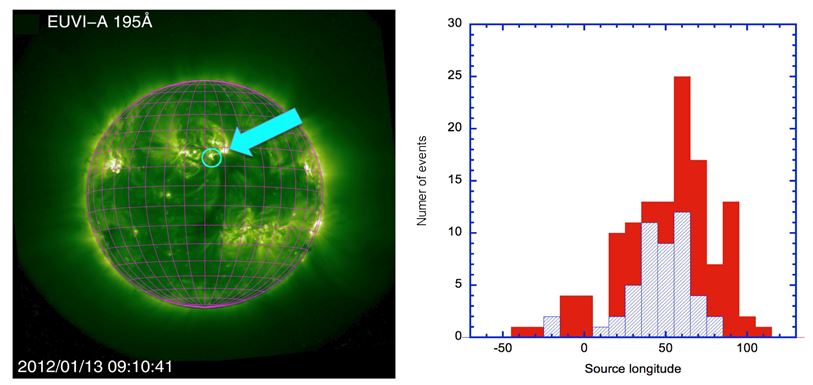Solar Sources of 3He-rich Solar Energetic Particle Events
PDF version

Left panel: Arrow points to a jet at west that was the source of a 3He-rich
event observed on ACE whose source was not visible from Earth, but was visible
from STEREO-A. Right panel: Longitude distributions of 3He-rich events
observed at L1 based on 1980-90s data (hatched) and recent results (solid)
which show a much wider longitude range of sources.
3He-rich solar energetic particle events are associated with magnetic reconnection in solar active regions, that produce small events with enrichments of the rare isotope 3He by factors of ≥ 1000 and nuclei from C to Fe by factors of 3-10 (e.g., ACE News #171, 169, 137). Studying 3He-rich SEP events has been significantly hampered by difficulties in definitively identifying their solar sources due to the small size of the events. The enormous improvement in solar imaging resulting from SDO, combined with multipoint observations from the STEREO and ACE have recently allowed identification of several significant new properties of these events: they are sometimes associated with eruptions and motions of coronal material at larger scales than the previously identified small jets; a single active region can produce these events seemingly continuously over a couple of weeks or longer; and for the first time, these direct observations have connected several 3He-rich SEP events with sources beyond the solar limb as viewed by the observer, further confirming the unexpected large spread of these particles in the interplanetary medium. The left panel of the figure shows an example of a 3He event pinpointed by a jet clearly seen from STEREO-A but hidden from Earth. The right panel shows source locations from 3 recent surveys (solid histogram) that show a much broader longitude distribution than earlier studies (hatched histogram). These observations provide key clues regarding the acceleration processes in the corona and the efficient transport of SEPs in space. Through their frequent and extended generation, these events may contribute significantly to the suprathermal ion pool in the inner solar system and point to a general energization mechanism associated with magnetic reconnection that undoubtedly also occurs at other astrophysical sites. For additional details and references, see Nitta et al. (ApJ 806, 235, 2015) and Chen et al (Astron & Astrophys, June 2015).
This item was contributed by G.M. Mason (APL), C.M.S. Cohen (Caltech), and M.E. Wiedenbeck (JPL/Caltech). Address questions and comments to
ACE News Archives
Subscribe to ACE News
ACE Homepage
Last modified 29 Sept 2015.